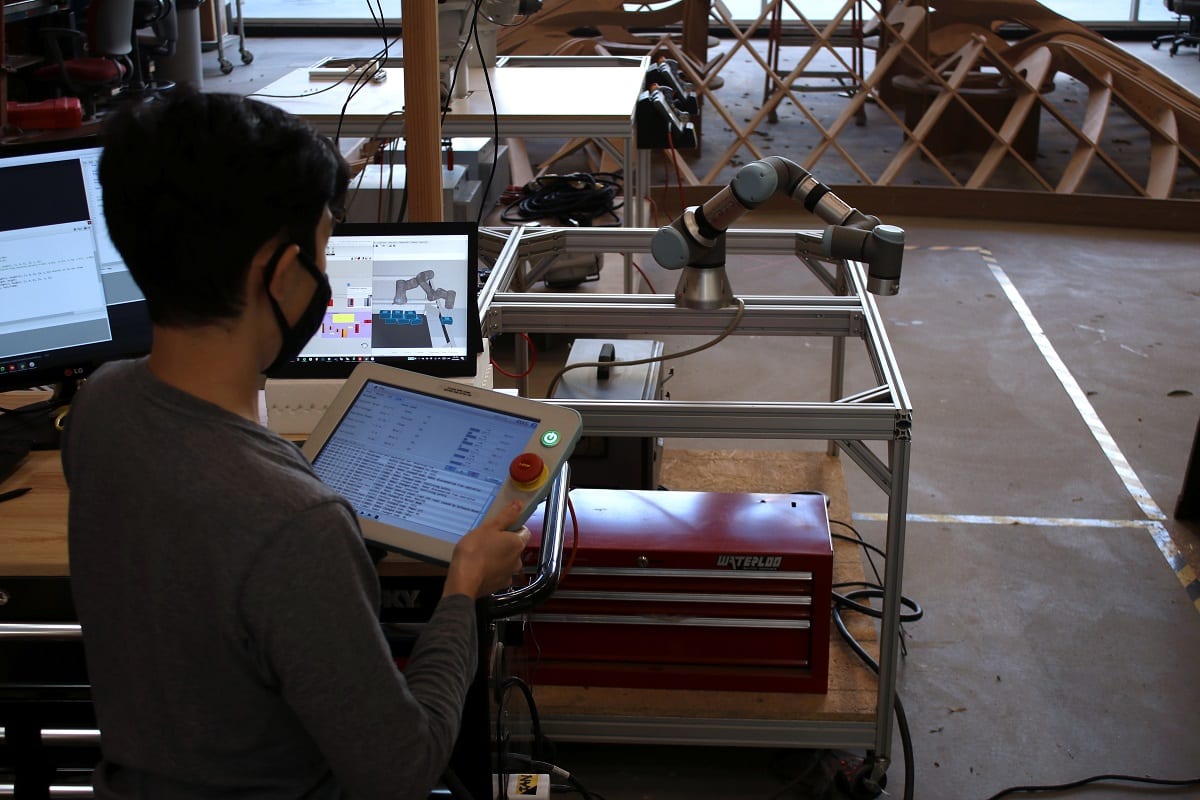By Jon Garaffa ’20, Humanities Council
COVID-19 circumstances are sparking an innovation in architectural robotics. A Humanities Council Rapid Response Magic Grant, which boosts humanistic scholarship and community amid social distancing, has supplied graduate assistance and minor equipment for “Human-Robot Interaction.” This initiative turns the University into one of the first American architecture schools to have a robust and accessible system of working with robotic arms, according to project leader Stefana Parascho (Architecture).
Robotic arms serve as a primary tool in digital fabrication, a manufacturing process that uses computer-controlled machines to fashion products based on digital designs. The arms offer cutting-edge precision and strength, completing tasks that would challenge or even endanger humans. For example, robots can precisely place glass bricks to construct an elegant, double-curved structure without scaffolding.
“Human-Robot Interaction” allows remote control of the industrial six-axis robotic arms of the Embodied Computation Lab at the School of Architecture. Furthermore, the project streamlines the training process for the lab’s users through consolidated documentation. Helping bridge the gap between science and the humanities, the initiative increases access by architects and designers to the latest technologies, while minimizing their physical presence in the lab.
Parascho hired Ian Ting, a second-year Master of Architecture candidate, as the graduate student worker for the project. Ting has focused on establishing a way of remote communication with the robotic arms. This method sends instructions to the arms, via the Internet, through a student or researcher’s computer. In addition, Ting has helped to configure the arms’ hardware, produce training documentation, and troubleshoot the newly developed software. Mark Skepasts ’22 also contributed to the training documentation and created demo exercise files to walk students through bot setup.
The new program builds upon the open-source COMPAS_fab2 framework developed at ETH Zurich, along with the open-source Robot Operating System (ROS)3 and the computer-aided design software Rhinoceros 3D. Users issue commands to the robotic arms through Rhinoceros 3D, remotely controlling the robot to implement designs. The project team uploaded its instructions to GitHub, a code hosting platform, to keep training documents in one location.
As a major objective, the project aims to expand the range and convenience of tools available to students, architects, and designers. People with non-technical backgrounds in the humanities could especially benefit. So could architects not previously trained to configure or calibrate a robotic arm.
“The main goal of this research is to make technology more accessible for those who may not be as tech-savvy or inclined,” Parascho said. “Barriers against usage right now are high, and they shouldn’t be. I’d like to see more architects and designers use these technologies, and with confidence.”
Before “Human-Robot Interaction,” the lack of a universal way of controlling the robotic arms frustrated current and aspiring architects on campus. “One main problem we were trying to solve is that there was no central setup that everyone would use–each researcher would have their own software,” Parascho explained. She added that sometimes, the variety of setups would result in accidental code erasures when new users switched to their own setup. Furthermore, as they trained, students found adjusting to multiple software versions and setups quite confusing.
Several factors have increased the demand for remote accessibility. Though underused, the School of Architecture’s robotic arms are attracting more and more interest. Moreover, COVID-19 has limited the number of students permitted in the lab.
Yet even outside the lab, the training process for remote setup can require much troubleshooting, especially if the trainee does not know how to code using the software. The project team hopes to ease this transfer of knowledge by providing documentation, which details processes such as installation and configuration.
Parascho’s undergraduate Fall 2020 course ARC 311: “Building Science and Technology: Building Systems” applied the new remote software, as will her Spring 2021 graduate course ARC 574: “Computational Fabrication in Architecture.” “The most fulfilling part was helping to teach the class at the end, seeing that the students were able to learn about architectural robotics successfully,” Ting noted of “Building Systems.”
Other universities are also adapting to this new niche, designing similar software and means to operate robots remotely. Throughout the spring semester, the team plans to fix any remaining issues in the software. Open-source, the software is available for anyone to use or modify, so the researchers hope it will facilitate inter-university and even overseas collaboration.
















